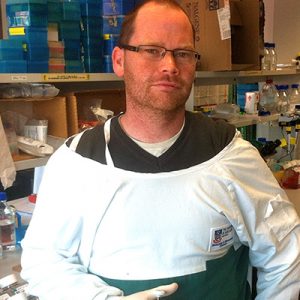Summary
In MS white blood cells of the immune system enter the central nervous system (CNS) where they are thought to play a major role in driving disease and CNS degeneration. However, CNS degeneration also occurs through non-immune mechanisms.
The work in this application will use laboratory models of MS and study samples of human MS tissue to investigate the role of two enzymes in controlling white blood cell activation and migration. This study has potential to lead to novel therapeutics for patients with MS, will increase understanding of activation and migration of white blood cells and determine whether these molecules regulate demyelination and remyelination of the CNS.
Project Outcomes
Dr Iain Comerford, working at the University of Adelaide School of Molecular and Biomedical Science, was awarded a 3 year fellowship by MS Research Australia in 2010 to research two enzymes that regulate immune function.
The enzymes being investigated are called ‘p110δ’ and ‘p110γ’. His research utilises laboratory models of MS to investigate the role of the two enzymes in controlling white blood cell activation and migration. These enzymes are vital for the function of a multitude of white blood cells, including T cells, B cells and neutrophils. They are therefore promising targets for drugs that prevent or treat inflammation and autoimmunity. 'In multiple sclerosis (MS), white blood cells of the immune system enter the central nervous system (CNS) where they are thought to play a major role in driving disease and CNS degeneration,' reported Dr Comerford 'However, CNS degeneration also occurs through non-immune mechanisms.'
In his research, Dr Comerford has used a laboratory model of experimental autoimmune encephalomyelitis (EAE) to study the role of these enzymes in driving the central nervous system damage. He has published a manuscript in the Journal of Autoimmunity which presents data demonstrating that the enzyme p110δ is required for full and sustained pathology of EAE and that this enzyme is required for optimal activation of a subset of T cells which cause disease in both EAE and MS. In addition, Dr Comerford has discovered that the other enzyme, p110γ, is also required for EAE to progress as mice with a deficiency of p110γ have a variety of immune system defects that block the disease process. Importantly, Dr Comerford has shown that treating EAE mice with an orally active drug which inhibits the p110γ enzyme, reverses the pathology of the disease.
The remainder of this study will now focus upon the role of these two enzymes in a non-autoimmune model of MS in which a toxin called cuprizone is used to damage myelin.
An important part of a post-doctoral fellowship, such as the award made to Dr Comerford, is to develop collaborations to enable the researcher to establish an independent career as an MS researcher in the future. To this end, Dr Comerford has been working in collaboration with Associate Professor David Booth at Westmead Millennium Institute, Sydney, for the genetic analysis part of his project and with the MS Research Australia Brain Bank to obtain MS tissue for his studies. He has also been supervising and mentoring two PhD students, one of whom has recently graduated; this is also a vital contribution to training the next generation of MS researchers.
Publications
- Comerford I, Haylock-Jacobs S, Kara E, Bastow C, Litchfield W, Fenix K, Smyth M, Hill G, Korner H, McColl SR. Contact-dependent TGF beta signaling between CD4+ and CD8+ T cells promotes CCR6 expression on CD4+ T cells. Immunology and Cell Biology (underway).
- Wikstrom M, Fleming P, Comerford I, McColl S, Andoniou C, and Degli-Esposti M. A chemokine-like viral product enhances IFN-α production by plasmacytoid dendritic cells but delays CD8+ T cell activation and impairs viral clearance. Journal of Virology. Under revision. Reviews received 13/2/13.
- Kara E, Comerford I, McColl SR. Distinct chemokine receptor axes regulate T helper 9 cell trafficking to allergic and autoimmune inflammatory sites. Journal of Immunology (underway).
- Comerford I, Harata-Lee Y, Bunting M, Gregor C, Kara E and McColl SR. A myriad of functions and complex regulation of the CCR7/CCL19/CCL21 chemokine axis in the adaptive immune system. Cytokine Growth Factor Rev (2013). In Press.http://dx.doi.org/10.1016/j.cytogfr.2013.03.001.
- Kara E, McColl SR, Comerford I, The basophil: resolved questions and new avenues of investigation. Bioessays. (2013) Accepted 27/3/13.
- Wiede F, Fromm PD, Comerford I, Kara E, Bannan J, Schuh W, Ranasinghe C, Tarlinton D, Winkler T, McColl SR, Korner H. CCR6 is transiently upregulated on B cells after activation and is involved in selection for germinal centre entry. Immunology and Cell Biology. (2013) Accepted 6/3/13.
- Bunting MD, Comerford I, Seach N, Hammett M, Nibbs R, Asquith D, Korner H, Boyd R, McColl SR. CCX-CKR regulates thymic CCL25 distribution, promotes outward migration of DN thymocytes and reduces spontaneous autoimmunity. Blood. 2013 Jan 3: 121(1)118-28.
- Fiorenza S, Kenna TJ, Comerford I, McColl S, Steptoe RJ, Leggatt G, Frazer I. A combination of local inflammation and central memory T cells potentiates immunotherapy in the skin. Journal of Immunology. 2012 Dec 15: 189(12): 5622-31.
- Comerford I, Litchfield W, Kara E, McColl SR. PI3Kγ drives priming and survival of autoreactive CD4+ T cells during experimental autoimmune encephalomyelitis. PLoS One. 2012;7(9):e45095. doi: 10.1371/journal.pone.0045095. Epub 2012 Sep 13.
- Haylock-Jacobs S*, Comerford I, Bunting M, Kara E, Townley S, Klingler-Hoffmann M, Vanhaesebroeck B, Puri KD, McColl SR. PI3Kδ drives the pathogenesis of experimental autoimmune encephalomyelitis by inhibiting effector T cell apoptosis and promoting Th17 differentiation. Journal of Autoimmunity. 2011 May;36(3-4):278-87.
- Comerford I, McColl SR. Mini-review series: Focus on chemokines. Immunology and Cell Biology. 2011 Feb;89(2):183-4.
- Bunting MD, Comerford I, McColl SR. Finding their niche: chemokines directing cell migration in the thymus. Immunology and Cell Biology. 2011 89(2):185-96.
- Comerford I, Bunting M, Fenix K, Haylock-Jacobs S, Litchfield W, Harata-Lee Y, Turvey M, Brazzatti J, Gregor C, Nguyen P, Kara E, McColl SR. An immune paradox: how can the same chemokine axis regulate both immune tolerance and activation? CCR6/CCL20: a chemokine axis balancing immunological tolerance and inflammation in autoimmune disease. Bioessays. 2010; 32:1067-76.
- Williams SA, Harata-Lee Y, Comerford I, Anderson RL, Smyth MJ, McColl SR. Multiple functions of CXCL12 in a syngeneic model of breast cancer. Molecular Cancer. 2010; 9: 250.
- Comerford I, Nibbs RJ, Litchfield W, Bunting M, Harata-Lee Y, Haylock-Jacobs S, Forrow S, Korner H, McColl SR. The atypical chemokine receptor CCX-CKR scavenges homeostatic chemokines in circulation and tissues and suppresses Th17 responses. Blood 2010; 116(20):4130-40.
Updated: 12 June 2013


